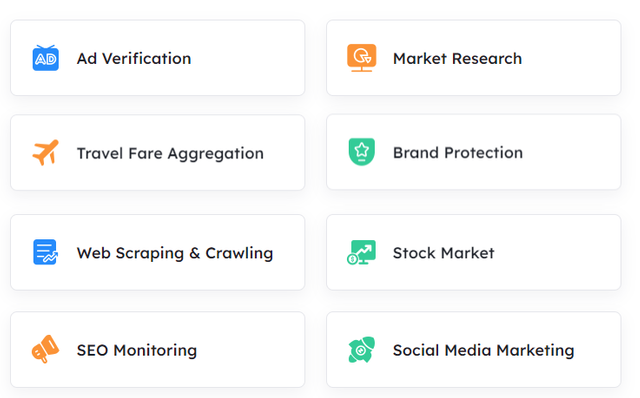Many users encounter the “Your IP has been temporarily blocked” prompt when browsing different websites. This not only limits your access speed, but can also seriously affect your work progress. For users who need to frequently access specific websites, such blocking can make things even more complicated.
But don't worry, this article will explore the common causes of IP blocking in depth, understand the mechanism behind this problem, and help you discover effective solutions to avoid IP address blocking, especially how to use Residential Proxies IP to solve this problem. Next, we will reveal the impact of IP blocking and how Residential Proxies can be used to combat this problem.

What is an IP block and what is the reason for the message “IP temporarily blocked”?
What does IP blocking mean? Simply put, every time you visit a website, it uses your IP address to identify who you are and where you are coming from. Your IP address is like your “internet identity tag”. If you frequently visit certain websites or use tools that frequently refresh or scrape data, the website may think you are engaging in malicious behavior and temporarily block your IP address to prevent you from continuing to access it. This is why you see the “Your IP has been temporarily blocked” prompt.
Other common causes of IP blocking include:
- Frequent visits or operations: A large number of requests may make the server think you are a malicious user, such as data scraping.
- IP address sharing issues: When using a public network, multiple users share the same IP, and improper operations by someone can lead to IP blocking.
- Failure to comply with website access rules: Some websites set rules for access frequency, behavior, etc., and will be blocked when exceeded.
What is a Residential Proxies IP?

So the question is, how can you deal with this situation? This is where Residential Proxies come in. What areResidential Proxies? Put simply, they are a proxy service that accesses websites on your behalf via the “real” home user network (i.e. the IP address assigned by your ISP).
Unlike data center proxies, which are easily blocked, Residential Proxies are more legitimate and credible because they come from a real user network, and are therefore less likely to be identified or blocked by websites. It's like changing your “identity” in the online world. If you use Rotating Residential Proxies, you can set different times to access the target website using different real IP addresses, greatly reducing the chance of being blocked.
How do Residential Proxies IP address resolve “IP blocking” issues?
(1) Use a proxy IP address to restore normal access
The biggest advantage of Residential Proxies is that they can simulate a real user network and provide you with a variety of different IP addresses to use. If your current IP address is blocked, using a Residential Proxy IP, you can easily adjust to a completely new IP address, thereby avoiding website blocking.
(2) Distribute traffic to reduce the risk of being blocked
If you need to frequently access a certain website, Residential Proxies can allow you to use a different IP address each time you access it, so that the website will not detect that you are the same user repeatedly requesting, thereby avoiding triggering the website's protection mechanism.
(3) Circumvent restrictions
Some websites will deny access to users based on their IP address, for example, some content can only be viewed in specific regions. With Residential Proxies, you can choose an IP address from a different country and access any content you need.
Specific application scenarios of Residential Proxies
Residential Proxies are not just a powerful tool for solving IP blocking issues, they are also widely used in practical applications, especially in the following scenarios:

(1) Web data collection and web crawlers
IP blocking is a common problem for businesses or individuals that need to collect large amounts of web data. For example, when you are monitoring e-commerce prices or conducting market research, frequent requests may cause your IP to be blocked by the target website. By using Residential Proxies to distribute traffic requests, you can simulate multiple real users and avoid being identified and blocked.
(2) E-commerce platform account management
If you operate multiple accounts on multiple e-commerce platforms, logging in to multiple accounts using the same IP address may arouse the platform's suspicion and even lead to the risk of account suspension. Residential Proxies can help you assign an independent IP address to each account to ensure the security and anonymity of account operations.
(3) Advertising verification and detection
In the advertising industry, advertising verifiers often need to verify the display effect of advertisements from the perspective of users in different regions. Using Residential Proxies, you can simulate users from all over the world to ensure the accuracy and effectiveness of advertising.
(4) Streaming media and regional content access
Some streaming media services or website content may only be available to users in specific regions. By using Residential Proxies IP, you can obtain IP addresses from different countries and regions around the world and access streaming media content that would otherwise be unavailable.
How do I choose a good Residential Proxies IP service?
There are a few key points to consider when choosing a Residential Proxies IP service:
- IP Pool Size: A good Residential Proxies service offers a large selection of IP addresses, ensuring that you can find a suitable IP address worldwide, and that the IP address used for each visit is different, reducing the risk of being blocked.
- High concealment and stability: The stability and concealment of the proxy service is crucial. Choose Residential Proxies IP services that offer high stability and low latency to ensure that your work is not affected by connection problems.
- Wide regional coverage: Choose Residential Proxies IPs that cover major countries and regions around the world, especially those in regions you need to access frequently.
- Price and service support: Choose a proxy service provider that suits your budget, and preferably one that also provides professional technical support to deal with any problems you may encounter during use.
How to set up and use Residential Proxies after you have them
Here you can use PROXY.CC Residential Proxies, a leading global IP proxy service provider with coverage in 195 countries and 20,000+ individual and 100+ enterprise users. It offers Rotating Residential Proxies, Unlimited Traffic Residential Proxies and Static Residential Proxies, and uses advanced encryption technology and a privacy policy to ensure a safe and efficient internet browsing experience.
Setting up Proxies on Windows [Detailed guide to setting up Windows Proxies]
Open Settings: Click the “Start” button and select “Settings”.
Go to Network Settings: In the Settings window, click “Network & Internet”.
Select Proxies: On the left, select “Proxies”.
Set Proxies Manually: In the “Manual Proxy Settings” section, enable “Use a proxy server”.
Enter Proxy Information: Fill in the IP address and port number of the proxy server.
Save Settings: Click “Save” to enable the proxy. You can turn it off if necessary.Set up proxies on a Mac [Mac Proxies Detailed Setup Guide]
Open System Preferences: Click the Apple icon in the upper left corner of the screen and select “System Preferences”.
Go to Network Settings: Select the “Network” option.
Select Connection: In the list on the left, select your network connection (e.g. Wi-Fi) and click “Advanced”.
Proxy Settings: Go to the “Proxies” tab and select HTTP or HTTPS Proxies.
Enter Proxy Information: Fill in the IP address and port number, click “OK” and apply.Setting up proxies on Android [Android Proxy Detailed Setup Guide]
Open Wi-Fi settings: Go to the “Settings” app and tap “Network & Internet”.
Select Wi-Fi network: Tap the settings icon for the current Wi-Fi network.
Configure Proxies: Select “Advanced options” and set “Proxies” to “Manual”.
Enter proxy information: Enter the IP address and port number, and tap “Save”.Set up proxies on iOS [iOS Proxy Detailed Setup Guide]
Go to Wi-Fi settings: Open “Settings” and tap “Wi-Fi”.
Select Wi-Fi network: Tap the “Information” icon (i) next to the current Wi-Fi network.
Set up Proxies: In the “HTTP Proxy” section, select “Manual”.
Enter Proxies information: Fill in the IP address and port number, and tap “Back” to save the settings.
The proxy setting steps for each platform are relatively simple. The above briefly describes the key operating procedures for each, which can help you quickly set up Proxies.
Conclusion
The problem of “Your IP has been temporarily blocked” may seem troublesome, but in fact, by using Residential Proxies, you can easily bypass IP blocking and enjoy a more efficient and stable network experience. Whether you need to frequently access specific websites, conduct network data collection, or manage social media and e-commerce accounts across regions, Residential Proxies can provide you with the optimal solution.
Facing the various restrictions of the Internet, Residential Proxies are not only a “weapon” to help you stay productive, but also a reliable helper to deal with the complex network environment. Next time, when you encounter the prompt “Your IP has been temporarily blocked”, try using Residential Proxies to help you reconnect to the online world.